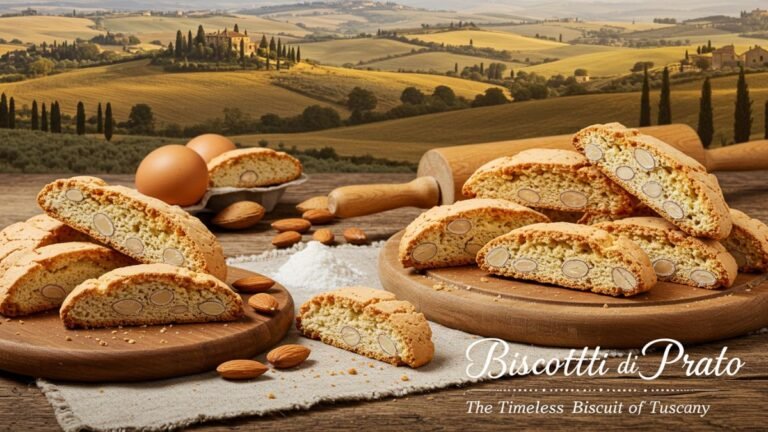A Crunchy Bite of Tuscany
If you’ve ever dipped a crispy cookie into your espresso or Vin Santo in a cozy Italian café, chances are you’ve tasted бишкоти ди прато — more commonly recognized as biscotti. But here’s the thing: бишкоти ди прато isn’t just any cookie. It’s a historic creation from the Tuscan city of Prato, carrying centuries of tradition and flavor in every bite.
Though the term “biscotti” is often used broadly to describe any crunchy, twice-baked cookie, in Italy, it refers specifically to this traditional almond biscuit. The spelling “бишкоти ди прато” is a transliteration likely influenced by Slavic or Central Asian pronunciation, but no matter how it’s written, the cookie remains unmistakably Italian.
The Origins: A Taste of Tuscan History
To appreciate бишкоти ди прато, we need to go back to medieval Tuscany. These cookies were originally crafted to meet a practical need: durable food for soldiers and travelers. The twice-baked method made them dry and firm, allowing them to last for weeks without spoiling. That same crisp texture also made them ideal for dunking into wine or coffee.
The earliest written record of biscotti di Prato appears in the 18th century, credited to pastry chef Antonio Mattei, whose Prato bakery still operates today. His version used flour, sugar, eggs, pine nuts, and whole almonds — and it set the standard for all future recipes.
The Art of the Twice Bake
The name “biscotti” comes from the Latin word meaning “twice cooked,” and that’s the secret behind бишкоти ди прато’s unique crunch. The dough is shaped into logs and baked once until golden. After cooling slightly, the logs are sliced diagonally and baked again. This second bake removes moisture and gives the cookie its crisp, dry finish.
What sets бишкоти ди прато apart is its purity. Traditional recipes avoid butter, oil, or leavening agents. That means no added fat, just the essential ingredients: flour, eggs, sugar, and almonds. The result? A biscuit that’s not too sweet, but rich in nutty flavor and satisfying texture.
A Proud Symbol of Italian Culinary Identity
бишкоти ди прато is more than a cookie — it’s a symbol of Italian heritage. In Tuscany, it’s served with Vin Santo, a sweet dessert wine, after meals. The ritual of dipping biscotti into Vin Santo softens the biscuit and releases its deep almond notes. It’s a comforting and elegant tradition that many Italians cherish.
The cookie also holds cultural significance in Prato, where historic bakeries still preserve their unique family recipes. Some versions of the cookie have earned special status under Italian food heritage laws, ensuring the tradition remains intact.
The Global Journey of бишкоти ди прато
From local favorite to global phenomenon, бишкоти ди прато has traveled far. In English-speaking countries, it’s often called simply “biscotti.” The coffee culture boom of the 1990s, particularly in the United States, helped make it a staple in cafés and gourmet stores.
However, many commercial versions of biscotti differ from the traditional recipe. They may be softer, sweeter, or filled with chocolate chips and dried fruit. While these versions are delicious, they stray from the simplicity that defines authentic бишкоти ди прато.
Even so, the biscuit’s global journey is a testament to its versatility. Whether high-end or homemade, it continues to bring a bit of Tuscany to tables around the world.
Modern Variations: Tradition Meets Creativity
While the original almond recipe remains beloved, бишкоти ди прато has inspired countless variations. Bakers today experiment with:
- Nuts: Hazelnuts, pistachios, or walnuts instead of almonds.
- Flavors: Anise seeds, cinnamon, or citrus zest for aroma.
- Chocolate: Dipped ends, cocoa dough, or chocolate chips.
- Special diets: Vegan and gluten-free versions with plant-based ingredients.
Each variation brings a new dimension to the classic, but the heart of бишкоти ди прато remains: crunchy, sturdy, and made for dipping.
Baking бишкоти ди прато at Home
Good news: you don’t need to travel to Tuscany to enjoy this classic treat. Making бишкоти ди прато at home is simple and rewarding.
Basic Recipe:
Ingredients:
- 2 cups all-purpose flour
- 3/4 cup white sugar
- 2 large eggs
- 1 tsp vanilla extract
- 1 cup whole almonds (toasted)
- A pinch of salt
Instructions:
- Preheat your oven to 350°F (175°C).
- Beat eggs, sugar, and vanilla until smooth.
- Mix in flour and salt to form a sticky dough.
- Add almonds and shape the dough into a log.
- Bake for 25–30 minutes, then cool slightly.
- Slice diagonally and bake the slices for 10–15 more minutes, flipping once.
You now have a batch of homemade biscotti — perfect for gifting, sharing, or savoring with your favorite drink.
More Than Just a Holiday Treat
Though it’s enjoyed year-round, бишкоти ди прато becomes especially popular during Italian holidays like Christmas, Easter, and family celebrations. It’s often included in dessert platters or given as a homemade gift.
Today, biscotti also appears in popular culture, from cooking shows to artisan food boxes. Families often treat the baking process as a shared tradition, passing recipes down through generations. Grandparents bake with grandchildren, sharing stories and creating memories as they mix, shape, and bake together.
Conclusion
In a dessert world full of sugary excess and fleeting trends, бишкоти ди прато remains grounded in tradition. It doesn’t rely on frosting, fillings, or fads. Its appeal lies in simplicity, quality ingredients, and a baking process perfected over centuries.
Whether you know it as biscotti or бишкоти ди прато, this crunchy cookie is more than a snack. It’s a link to Italy’s culinary past, a symbol of tradition, and a beloved companion to coffee and wine lovers worldwide.
So next time you bite into one, remember: you’re tasting history — and keeping a sweet, timeless tradition alive.
Read more: ANAG Test Demystified: Your Complete Guide


